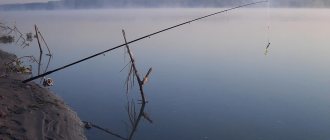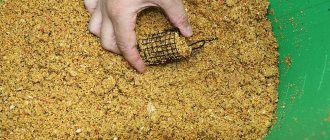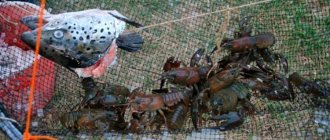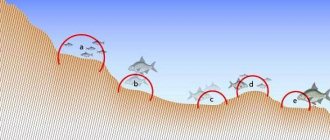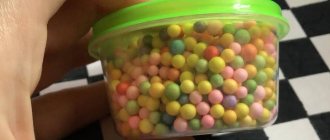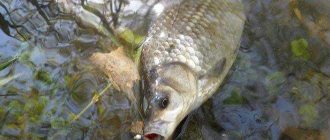Although it is hard to believe, crucian carp can be caught using ordinary foam balls. Of course, this requires special equipment, because fishing with foam plastic is not practiced with a regular float rod, and it is not technologically feasible. The advantage of such a bait is that you can catch as many fish as you like with one ball until the foam flies off the hook, and if it does, it’s not a big loss. Therefore, it turns out that fishing is not very expensive. If you find a piece of polystyrene foam, you can make a lot of these balls out of it. In this case, polystyrene foam of the lowest density is taken. It will not be possible to pick out balls from denser foam.
Tackle for catching crucian carp using polystyrene foam
To catch crucian carp using foam plastic, you will need bottom tackle with a spring-shaped feeder. Although many anglers believe that the “nipple” may be the most effective. The “crucian carp killer” tackle consists of several “spring” type feeders, located one after the other, so this option will be considered.
Before casting the tackle, the spring is stuffed with bait, and foam balls are placed on the hooks. As a result, it turns out that the pieces will be in the water column above the feeder due to positive buoyancy. The crucian carp will definitely become interested in the contents of the feeder and begin to eat its contents.
At the same time, when the crucian carp is feeding, the hooks with foam plastic are very close, since the length of the leashes can be only 5 cm. Having occupied the feeder, the crucian carp also swallows foam balls. As a result, the fish ends up on the hook. It self-cuts under the influence of the weight of the feeder. There are several versions among fishermen about the reason that crucian carp swallows foam balls:
- The crucian carp gets carried away with eating the contents of the feeder and at the same time swallows a foam ball. It's hard to say what the white ball reminds him of. It is quite possible that he sees a balloon in it and decides to swallow it in order to replenish his air reserves. There are also foam balls covered with a shell of different colors and smells. If the ball is similar to a pea or a grain of corn, then everything is clear: the crucian carp will not refuse such a delicacy. Having swallowed such a ball, the crucian carp immediately ends up on the fisherman’s hook.
- There is another opinion, which is based on the fact that crucian carp is still able to determine how edible the bait is. If everything is clear with multi-colored balls, since they can look like ripe peas, green peas, or corn and can smell the same, then with ordinary foam balls, on the contrary, nothing is clear. Most likely, the crucian carp has determined that there is some kind of garbage flying around its feeding area that needs to be removed. In addition, this garbage interferes with normal feeding and the crucian carp takes this ball into its mouth and tries to move it away from this place. So he ends up on the hook.
Equipment
Equipment for catching crucian carp using polystyrene foam is sold in any fishing store. There are many varieties, including the “crucian carp killer” rig. Other accessories, such as “pacifiers,” may be suitable for this purpose, but this is not for sale, since you can easily make it yourself. If you don’t want to spend precious time making equipment, then it’s better to buy, especially if funds allow. There can be 2-3 hooks near each feeder spring, although many fishermen attach up to 6 hooks. If they are secured correctly, on short leashes, they will not get tangled.
For the equipment to work correctly, it is necessary to properly secure the leashes with hooks. Usually they are attached to both sides of the feeder. On a purchased feeder, the hooks may not be tied as needed for fishing with foam, so they will have to be moved to another place. The most important thing is that the length of the leashes does not exceed 5 centimeters. As practice shows, this is the optimal length of leashes for such gear.
Rod
Since this is a bottom tackle, it must be equipped with any fishing rod, either a spinning rod or a feeder rod. Naturally, a feeder rod will cost much more. Many fishermen still use old Soviet spinning rods with inertial reels. Unfortunately, they are not suitable for catching crucian carp, since you will have to frequently re-throw the tackle, and it is difficult to determine bites on them. The fact is that bite detection is carried out by the movement of the rod tip. In this case, the softer the rod tip, the more sensitive the tackle, and old spinning rods are very rough and rigid.
Coil
For such fishing conditions, it is better to opt for a spinning reel. There are no special requirements for the reel, but it must be powerful, since you will have to throw significant weight over a long distance. The reel should fit at least 50 meters of fishing line, 0.3 mm thick. Spool size 2500-3000. This will be quite enough.
fishing line
Despite the fact that mostly you come across individuals that weigh no more than 150-200 grams, fishing line thinner than 0.25 mm cannot be used. A feeder filled with bait can weigh up to 100 grams and when casting, a thinner line simply won’t hold up.
Hooks must be attached to elastic leashes. It is better to use a thin white cord for this, although fishing line about 0.15 mm thick will do.
Fishing with foam. Equipment for fishing with foam plastic. Bottom tackle. Fishing. Fishing.
How to make a feeder - a spring for catching crucian carp with your own hands
Success in catching crucian carp and crucian carp depends on various factors. But the correct supply of bait comes first. When the feed mixture is supplied by the fisherman to a small fished area, the fish will quickly concentrate at this point. And if there is a hook with bait on the bait spot, then you won’t have to wait long for a bite.
Read Monofilament fishing line and rating of the best models
For fishing in standing waters, a spring feeder has proven itself to be excellent. It is quite simple to make from wire. Moreover, using wire of different thicknesses, you can get a whole arsenal of springs with different volumes and weights.
To make a spring feeder, you need to stock up on available materials and tools.
The wire can be made of any metal, but it is best to use copper or brass products. They are easy to use, do not corrode, and finding these types of wire is not difficult. The wire thickness is suitable in the range of 1-3.5 mm. It is better to make the first springs from thin and soft material. Then you can successfully work with thicker wire.
To make a sliding crucian carp feeder you will need a tube. It can be made from the core of a ballpoint or gel pen, a Chupa Chups candy stick, or from a metal tube.
You will need pliers or wire cutters to cut off the wire. It will be more convenient to bend large-diameter wire with round-nose pliers.
The simplest device for winding wire in the form of a spring is a rod, bolt or other cylindrical object.
To equip the spring, a piece of 0.3 mm monofilament line 50 cm long, as well as a rubber stopper or a lead pellet, is suitable.
How much foam do you need to hang on the hook?
Fishermen who have heard that crucian carp are caught using foam plastic also try to catch them, but in doing so they make one mistake. When hooking a foam ball, they don’t think about keeping it and the hook in the water column. As a result, the foam ball turns out to be too small and cannot lift the hook, or a heavy hook made of thick wire is used and the foam ball is not able to lift it. Therefore, the hook along with the foam sinks to the bottom and the likelihood that the fish will bite is practically zero. Therefore, before casting the tackle, you need to check whether the hook with foam plastic is sinking. It may happen that one large ball is enough, but sometimes you have to put 2 or 3 small balls in the form of a bead. To check, just throw the tackle into the water near the shore, where the depth is not great and the bottom is visible. If the hook with the ball rises and is placed in the water column, then everything is in order. If the hook does not come off the bottom, then you need to add foam or use another hook made of thin wire.
Fishing stores sell foam balls of any color and with any flavor. Because the foam is encased, it does not have the same characteristics as regular white foam. To use purchased foam, you will have to use hooks with a long shank and made of thin wire, since you will have to attach at least 2 or 3 balls. At the same time, balls of various sizes are sold, which allows you to choose balls for any occasion.
Types of springs
Donkey springs are distinguished according to the following criteria:
- Form;
- Size;
- Presence/absence of a sinker.
Donut spring
- This is the name given to a fairly long compression spring that curls into a ring.
- The average diameter of the base of such a spring is 1-1.5 cm, while the diameter of the “donut” itself into which it can be compressed is most often around 4-5 cm.
- The leashes are not attached to the spring itself, but through a special leash. Look at the photo on the right. The shape of the spring makes it easy and convenient to fill it with porridge.
Harvester spring (cone)
- The harvester is another type of spring that is clearly recognizable by its cone-shaped shape.
- Leashes, as a rule, are attached to the top of this kind of cone.
- It’s also a fairly convenient and compact spring, which won’t be difficult to get.
Crucian carp killer:
- Three springs in series without lead.
- There is one hook on each spring.
- The length of the leashes is 5 cm.
- Braided leashes.
- Hooks 4-6 numbers.
- The distance between the leashes is 12 cm.
- At the end of the line there was a sinker weighing 20-50 grams.
Read Techniques for catching carp with a spring and preparing porridge
Very often, fishermen hook lard or foam onto their hooks, which increases the buoyancy of the hook and makes it easier for the fish to suck it in along with the porridge.
How to attach foam to a hook
When placing foam on a hook, the main condition is that the tip of the hook is always open. Moreover, no matter how many balls are placed on the hook. Under this condition, the fish will always catch on the hook. If this is not done, then the chances of the fish being detected are very small. In this case, fishing may not be effective.
Catching crucian carp with polystyrene foam means that it hooks itself. When he gets hooked, he tries to get away, but the weight of the feeder prevents him from doing so. As a result, the hook thoroughly hooks the fish, after which it will no longer be able to leave the hook. But she continues to try, as evidenced by the movement of the rod tip. The fisherman can only begin to reel in the fishing line, pulling the next crucian carp ashore. Since there may be more than one hook, there may be as many crucian carp. Therefore, fishing with polystyrene foam is very effective. The main thing is to choose strong, thin, but sharp hooks. As a rule, imported hooks from well-known companies have similar characteristics. Domestic hooks are not suitable for this type of fishing.
Catching carp and crucian carp using flavored foam plastic
Fishing technique
Before you start throwing foam balls, you need to feed the future location. After this, food is poured into the feeder, foam is put on the hook and the tackle is thrown into the water
After this, it is important to be on guard all the time, because a fish that has hooked itself will begin to escape, and you need to be prepared for this.
At this point, you need to keep the line taut until the fish is on the shore. You can’t give in any slack, because the crucian carp can easily get away. Experienced fishermen recommend pulling the trophy with a rod, making upward movements, and during the period of lowering, simply reeling in the line with a reel. If fishing is carried out close to the reeds, you must ensure that the fish does not go into the thickets, otherwise there will be neither a trophy nor a fishing line. You should keep your catch in clean water until it is in the net. Small specimens can be easily pulled out just like that, but large ones cannot be managed without a landing net. Many fishermen said that at the very last moment, when they were about to rejoice at the trophy, it suddenly broke down and left.
Of course, catching crucian carp with foam plastic may seem unusual and unusual to some, but once you try it, it will be difficult to give up. If you choose your tackle and bait wisely, a positive result will not be long in coming.
Using bait
For a more active bite, when catching crucian carp, various types of bait are used. These can be either purchased, ready-made mixtures or home-made ones. For those who do not want to stand at the stove and cook porridge, it is enough to purchase bait at a fishing store. Moreover, it is not necessary to ask the seller anything, since each package indicates what kind of fish the bait is intended for catching. Of course, if you constantly buy bait in the store, then fishing can turn out to be “golden”. In this regard, many fishermen practice preparing their own bait.
Naturally, you need to know what bait should be for crucian carp. In addition, the specifics of fishing with a spring require bait, which has a special consistency. The fact is that the bait from such a feeder is quickly washed out. In this regard, you need to compact the bait tightly into the feeder. But this still does not guarantee effective fishing, since the bait must open after some time. Thus, a feeding spot will be formed, which will keep the crucian carp at the fishing point. Therefore, each time it is necessary to throw the tackle in the same place.
Many fishermen do not particularly prepare baits with a large number of ingredients. They practice preparing porridge containing a couple of ingredients, or even prepared from one grain, for example, pearl barley. At the same time, they do not stand at the stove, but steam the barley in a thermos. This method is convenient because you don’t have to spend a lot of time on preparation. Barley is filled with boiling water before going fishing. In the time it takes to get to the reservoir, the pearl barley is ready for use. Near the pond, dry ingredients are added to it, for example, makha (cake), to bring the bait to the desired consistency. You can also get water here if needed.
In any case, if you prepare the bait yourself, it will be much cheaper, since most of the ingredients can be found in the kitchen.
If you look on the Internet, you can find a lot of different recipes that do not contain scarce ingredients.
Crucian carp on FOAM!!! Fishing for crucian carp on a NIPPER Tackle NIPPLANT
Bait for crucian carp
For catching crucian carp using polystyrene foam, any purchased crucian carp bait is suitable. It is advisable to choose one that will create a more abundant cloud of turbidity, thereby increasing the likelihood that the foam will be eaten by crucian carp. But if you don’t understand bait and the seller cannot tell you the most cloudy bait, then you can easily modify it yourself. To do this, just add cookies to the purchased bait.
So, a pack of “Jubilee” cookies is ideal for a kilogram bag of bait. You just need to add the cookies to the dry bait and mix it in the same form. Only after the ingredients are thoroughly mixed can you knead the bait by diluting it with water. Just keep in mind that it is optimal to use water from a reservoir. If you prepare bait at home by adding tap water, the smell of bleach can scare away the fish, thereby spoiling the entire effect of feeding.
There is no need to skimp on the bait on the spring feeder; add too much bait so that there is still a large layer of bait around the spring. The more bait there is on your spring, the greater the likelihood of crucian carp biting on the foam. Also try to always throw the tackle in the same place, then you will be able to catch crucian carp most effectively, creating a small feeding table for the crucian carp, on which it will spin for a long time.
If the crucian bite is good, then you may need quite a lot of bait; two bags of purchased bait per person is not always enough. You can make the fishing process much cheaper if you use homemade bait.
Where else can foam plastic help out?
Fishing with foam can be effective even in cases where fishing with classic baits does not produce any results. As a rule, polystyrene foam is effective in reservoirs with heavily silted bottoms. What's the matter here? But the fact is that, falling to the bottom, the feeder can gradually sink into the silt along with the nozzle. As a result, the crucian carp simply will not notice them. Experienced fishermen, knowing what's going on, twitch the rod from time to time, causing the feeder and the hook with the nozzle to move at the bottom. The task can be greatly simplified if you use polystyrene foam. It can be placed next to the main bait, and it will no longer drown in the mud. If everything is calculated correctly, then you can generally raise the hook with bait above the bottom, which will make fishing effective.
Catching fish such as saberfish requires that the bait be in the water column, since sabrefish do not feed from the bottom. It attacks the bait either at the moment when it slowly sinks to the bottom, or when it is in the water column. And here foam plastic can also help out. The main thing is to insert such an amount of foam so that the hook can rise from the bottom and can be in the water column. Then you can guarantee bites from other fish, such as grass carp or silver carp.
Features of rigs when fishing with foam plastic
The main function of the foam is to raise the hook with another attachment above the bottom. Therefore, you should measure the diameter of the ball with the weight of the hook, maggot, worm and other bait. If you use small hooks and a few maggots or bloodworms, then even a small pea will do
This neat attachment is suitable for fishing wary autumn roach and silver bream.
If you use more massive hooks and attach a worm, then take a larger ball. In general, in order not to have to guess again, just lower the feeder with the installed foam and nozzles into the water near you and look at the result. If the ascent occurs, then such a ball is suitable; if not, attach a slightly larger one.
For catching crucian carp and bream, use hooks No. 10 according to international numbering, for carp No. 6-8. When fishing for roach, sabrefish, silver bream and white bream, priority is given to hooks No. 12-18. In warm weather, larger models are used, and in cold weather, small ones.
Read Red fish - types and names
Most often, fishermen use medium-hard foam with a diameter of 4 to 6 mm. Such round pancakes retain their shape after many casts and contact with the bottom and do not turn into flat pancakes.
If you use more rigid foam, the number of unrealized bites will increase. Such an attachment will be rigidly fixed and will not slip further along the fore-end when cutting.
When we make a sandwich from several attachments, we first thread the foam through, and only then attach a maggot, or bloodworm, or worm. Fish, first of all, are interested in natural products to which they are accustomed.
Is it possible to put several balls on one hook? You can plant it, but this move does not provide any special advantages. It can be combined with the size of the balls, but in the vast majority of cases one pea is enough. In any case, we always leave the sting open. Here's how to properly install it:
If we fish with feeder rigs in rivers where there is a current, then we use leashes only from fishing line. Practice has shown that in reservoirs with running water, bites on baits with fishing line follow more often. Chekhon is caught on long leashes and using paternoster and asymmetrical loops.
When fishing with springs and plugs, you can use braided leashes. Fishing with such rigs usually takes place in stagnant bodies of water. Such leashes do not bother carp, crucian carp, tench and bream. They are much stronger than line ones, and there are practically no breaks during fishing. The shelf life of such leashes is calculated at 3-4 fishing trips, and even more, until the feeder is lost or the hook becomes dull. Bottom rigs for fishing on foam plastic look like this:

